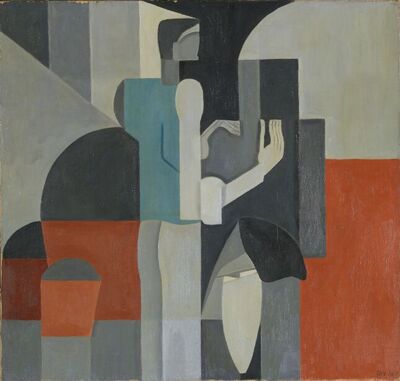Forskjell mellom versjoner av «Stående figur»
Fra hf/ifikk/kun1000
(→Innholdsanalyse) |
(→Innholdsanalyse) |
||
| Linje 10: | Linje 10: | ||
A diagonal line can be observed going from the top left corner, across the figure's shoulder bone and finishing at the bottom right, almost separating the artwork in two. | A diagonal line can be observed going from the top left corner, across the figure's shoulder bone and finishing at the bottom right, almost separating the artwork in two. | ||
| − | The top part, is made of straight lines and architectural shapes, that could've been inspired by Le Corbusier, a Swiss avant-garde architect, that Charlotte Wankel met in Paris. Aside from Le Corbusier's influence, she could have also been inspired by the street of Paris, which are usually made of rectangular gray buildings. | + | The top part, is made of straight lines and architectural shapes, that could've been inspired by Le Corbusier, a Swiss avant-garde architect, that Charlotte Wankel met in Paris.<ref>''Store norske leksikon online'', "Le Corbusier"[https://snl.no/Le_Corbusier]</ref> Aside from Le Corbusier's influence, she could have also been inspired by the street of Paris, which are usually made of rectangular gray buildings. |
The bottom part is made of rounder shapes, reminding us of nature. | The bottom part is made of rounder shapes, reminding us of nature. | ||
Revisjonen fra 24. okt. 2021 kl. 17:24
Her kommer det tekst i løpet av høsten 2021.[1]
Motivbeskrivelse
mer om motiv
Formspråk
Innholdsanalyse
A diagonal line can be observed going from the top left corner, across the figure's shoulder bone and finishing at the bottom right, almost separating the artwork in two.
The top part, is made of straight lines and architectural shapes, that could've been inspired by Le Corbusier, a Swiss avant-garde architect, that Charlotte Wankel met in Paris.[2] Aside from Le Corbusier's influence, she could have also been inspired by the street of Paris, which are usually made of rectangular gray buildings.
The bottom part is made of rounder shapes, reminding us of nature.
Litteratur
Fullstendig oppføring.
